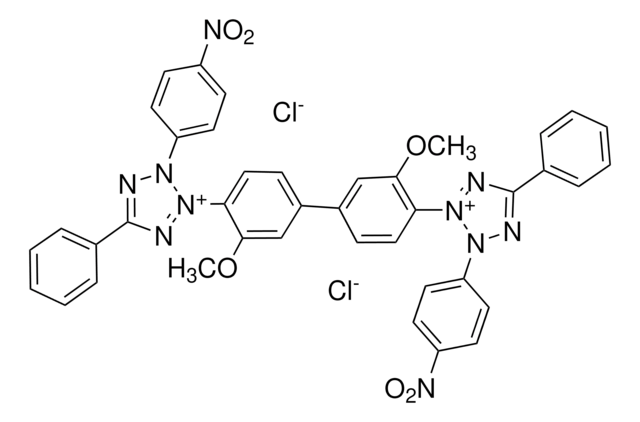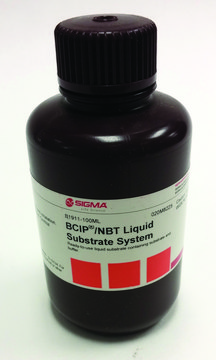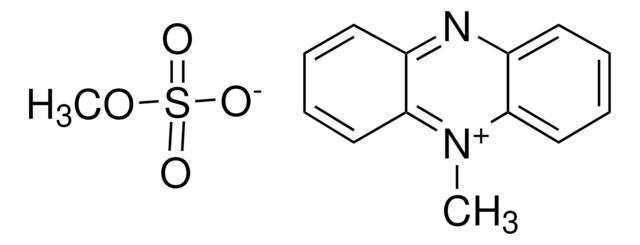推荐产品
描述
4-Nitro blue tetrazolium chloride, crystals
质量水平
表单
crystals
包装
pkg of 5 g
制造商/商品名称
Roche
储存温度
2-8°C
SMILES字符串
[Cl-].[Cl-].COc1cc(ccc1-[n+]2nc(nn2-c3ccc(cc3)[N+]([O-])=O)-c4ccccc4)-c5ccc(c(OC)c5)-[n+]6nc(nn6-c7ccc(cc7)[N+]([O-])=O)-c8ccccc8
InChI
1S/C40H30N10O6.2ClH/c1-55-37-25-29(13-23-35(37)47-43-39(27-9-5-3-6-10-27)41-45(47)31-15-19-33(20-16-31)49(51)52)30-14-24-36(38(26-30)56-2)48-44-40(28-11-7-4-8-12-28)42-46(48)32-17-21-34(22-18-32)50(53)54;;/h3-26H,1-2H3;2*1H/q+2;;/p-2
InChI key
FSVCQIDHPKZJSO-UHFFFAOYSA-L
正在寻找类似产品? 访问 产品对比指南
一般描述
NBT可溶于水、水性缓冲液和二甲基甲酰胺。
四唑盐可用于测定多种来源细胞的代谢活性。含有四个氮原子的四元四唑环核心具有净正电荷,通过膜电位诱导细胞摄取。这推动了它在细胞生物学领域的应用。在免疫标记技术中,硝基蓝四氮唑(NBT)可用作氧化剂。 碱性磷酸酶水解5-溴-4-氯-3-吲哚磷酸酯(BCIP)产生靛白,然后被NBT还原,形成不溶性蓝色BCI。NBT是一种无色/黄色染料,可被某些细胞还原而产生蓝色或黑色甲臜晶体。NBT的这种性质使其成为氧化还原组织化学和生物化学应用的首选染料。它曾被用于区分非细菌性和细菌性疾病,其中,细菌性疾病可导致中性粒细胞还原染料;用于确诊慢性肉芽肿病。
应用
- 菌落和噬菌斑杂交
- 免疫组织细胞化学
- 原位 杂交
- Northern印迹
- Southern印迹
- 蛋白质免疫印迹
NBT已可用于 原位 杂交。
质量
在LDH测定中的性能可控。
制备说明
工作溶液:溶解度: 溶于水、水性缓冲液和二甲基甲酰胺。可溶于甲醇。可得到浓度为20 mg/ml的澄清溶液。
分析说明
吸光度: NBT 在260 nm[溶剂为水]具有最大吸光度,
终产物甲臜在605 nm[溶剂为硝基苯]中具有最大吸光度。
终产物甲臜在605 nm[溶剂为硝基苯]中具有最大吸光度。
其他说明
仅用于生命科学研究。不可用于诊断。
警示用语:
Warning
危险分类
Acute Tox. 4 Oral - Eye Irrit. 2 - Skin Irrit. 2 - STOT SE 3
靶器官
Respiratory system
储存分类代码
11 - Combustible Solids
WGK
WGK 2
闪点(°F)
does not flash
闪点(°C)
does not flash
Infection and nitroblue-tetrazolium reduction by neutrophils: A diagnostic aid.
Park B H, et al.
Lancet, 292(7567), 532-534 (1968)
D Liebhart et al.
Journal of comparative pathology, 135(4), 237-242 (2006-10-31)
For use in an in-situ hybridization method, three probes (HM, TR and BL) were designed to hybridize, respectively, with (1) Histomonas meleagridis, (2) Tetratrichomonas gallinarum, and (3) a broad range of micro-organisms, including Blastocystis spp. Mono-eukaryotic cultures were used to
Tetrazolium dyes as tools in cell biology: new insights into their cellular reduction.
Berridge M V, et al.
Biotechnology Annual Review, 11, 127-152 (2005)
Fluorescent in situ hybridization employing the conventional NBT/BCIP chromogenic stain.
Trinh L A, et al.
Biotechniques, 42(6), 756-759 (2007)
Wanlong Su et al.
Frontiers in plant science, 11, 568411-568411 (2021-02-09)
Salt stress is an adverse environmental factor for plant growth and development. Under salt stress, plants can activate the selective autophagy pathway to alleviate stress. However, the regulatory mechanism of selective autophagy in response to salt stress remains largely unclear.
实验方案
NBT Protocol
我们的科学家团队拥有各种研究领域经验,包括生命科学、材料科学、化学合成、色谱、分析及许多其他领域.
联系技术服务部门




